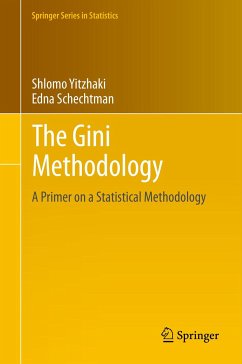This book focuses on imitating analyses that are based on variance by replacing variance with the GMD and its variants. In this way, the text showcases how almost everything that can be done with the variance as a measure of variability, can be replicated by using Gini. Beyond this, there are marked benefits to utilizing Gini as opposed to other methods. One of the advantages of using Gini methodology is that it provides a unified system that enables the user to learn about various aspects of the underlying distribution. It also provides a systematic method and a unified terminology.
Using Gini methodology can reduce the risk of imposing assumptions that are not supported by the data on the model. With these benefits in mind the text uses the covariance-based approach, though applications to other approaches are mentioned as well.
Dieser Download kann aus rechtlichen Gründen nur mit Rechnungsadresse in A, B, BG, CY, CZ, D, DK, EW, E, FIN, F, GR, HR, H, IRL, I, LT, L, LR, M, NL, PL, P, R, S, SLO, SK ausgeliefert werden.
"The book The Gini methodology by S. Yitzhaki and E. Schechtman is based on Gini's Mean Deviation (GMD) and the methodology based on it. ... To a student acquainted with the usual methods of statistics, the book provides an interesting alternative technique which makes for very good reading. Even at an advanced level, it provides a refreshing perspective through which the traditional methods can examined." (Sugata Sen Roy, Mathematical Reviews, February, 2014)
"In recent decades we have seen a growing interest of scholars of different cultural background on the results and problems related to Corrado Gini's scientific production and in particular on the mean difference (GMD) and his famous "concentration ratio" also known as Gini inequality index or Gini coefficient (GI). Now, these scholars have a fresh and clear source from which to draw information and ideas to satiate their thirst for knowledge by reading the very interesting and stimulating book "The G
ini methodology: a primer on a statistical methodology" authored by Shlomo Yitzhaki and Edna Schechtman and published in January 2013 by Springer.
It is a book that addresses the theoretical, methodological and applicative aspects related to a set of measures based on the GMD and the GI. The book proposes solutions, but also invites to make further analysis, to address problems not yet resolved, to find alternatives to some aspects not yet fully analyzed and to suggest new applications."
(Giovanni Maria Giorgi, Metron, Vol. 71 (2) 2013)
"The book The Gini methodology by S. Yitzhaki and E. Schechtman is based on Gini's Mean Deviation (GMD) and the methodology based on it. ... To a student acquainted with the usual methods of statistics, the book provides an interesting alternative technique which makes for very good reading. Even at an advanced level, it provides a refreshing perspective through which the traditional methods can examined." (Sugata Sen Roy, Mathematical Reviews, February, 2014)
"In recent decades we have seen a growing interest of scholars of different cultural background on the results and problems related to Corrado Gini's scientific production and in particular on the mean difference (GMD) and his famous "concentration ratio" also known as Gini inequality index or Gini coefficient (GI). Now, these scholars have a fresh and clear source from which to draw information and ideas to satiate their thirst for knowledge by reading the very interesting and stimulating book "The Gini methodology: a primer on a statistical methodology" authored by Shlomo Yitzhaki and Edna Schechtman and published in January 2013 by Springer.
It is a book that addresses the theoretical, methodological and applicative aspects related to a set of measures based on the GMD and the GI. The book proposes solutions, but also invites to make further analysis, to address problems not yet resolved, to find alternatives to some aspects not yet fully analyzed and to suggest new applications." -- (Giovanni Maria Giorgi, Metron, Vol. 71 (2) 2013)









